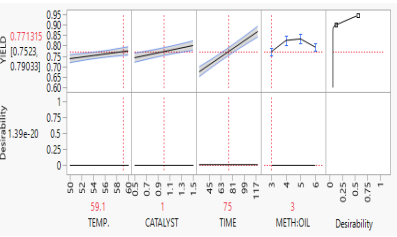Optimization of Biodiesel from Citrillus Lantanus Seed Oil using Alkali-Catalyzed Methanolysis
Keywords:
Biodiesel, Citrillus lantanus, transesterification, optimization, RSM, ANOVAAbstract
Biomass and agriculture derived materials are alternative sources of energy for the production of biodiesel. Renewable energy attracts wide attention due to its profound contribution to the ecosystem and its role as a sustainable energy source in substitution to diesel and the other petroleum based fuels. This study was conducted to synthesize biodiesel from Citrillus lantanus seed oil. The oil was extracted and characterized having a yield of 49%, density 0.92 g/cm3, acid value 2 mgKOH/g and viscosity of 26 cSt. The oil was characterized to get a high fuel quality in conformity with the American Standard for Biodiesel Testing Materials (ASTM-D6751) and the European Norm (EN-14214) standards. The experiment was designed and analyzed consisting of 28 number of runs by Response Surface Methodology—RSM technique. Four parameters that were studied and varied are temperature and time of reaction, catalyst concentration and methanol-oil ratio, and. The highest triglyceride conversion of 85% was achieved at 55 0C temperature, 30 mins reaction time, 0.5 g NaOH catalyst concentration, and 1:4 methanol-oil ratio. The optimal operating conditions while maximizing desirability was found to be 59.1 oC, 75min, 1.0 g/g, 1:3 of temperature, reaction time, catalyst loading, and methanol-oil molar ratio respectively to give a corresponding yield of 77.13% of biodiesel. The biodiesel produced was in conformity with ASTM standards.
References
N. Kapilan, T. P. Ashok and R. P. Reddy, "Technical Aspects of Biodiesel and its Oxidation Stability," Internationla Journal of Chemical Research, vol. 1, no. 2, pp. 278-282, 2009.
B. K. Highina, I. M. Bugaje and M. Umar, "Liquid Biofuels as Alternative Transport Fuels in Nigeria," Petroleum Technology Development Journal, vol. 12, January 2012.
H. Fukuda, H. Kondo and H. Noda, "Biodiesel fuel production by transesterification of oils," Jornal of Bioscience anf Bioengineering, vol. 5, pp. 405-416, 2001.
A. Demirbas, "Biodiesel from sunflower oil in supercritical methanol with calcium oxide," Energy Conversion Management, vol. 48 , pp. 937-941, 2007.
A. Hasan , "Biodiesel from Neem oil as an alternative fuel for Diesel engine," in 5th BSME International Conference on Thermal Engineering, 2013.
N. G. Rao, A. S. Ramadhas and N. Nakusamy, "Relationship among the physical properties of biodiesel and engine fuel system design requirement," International Journal of energy and environment, 2010.
B. R. Moser, "Biodiesel production, properties and feed stocks," Vitro Cell Development Biology – Plant, vol. 45, p. 229 – 266, 2009.
B. D. Kubmarawa, J. J. Nwaigwe, C. N. Kidah and D. Kekong, "Transesterification of Some Vegetable Oils for Use as Biofuel," Journal of Chemical Society of Nigeria, vol. 32, no. 2, pp. 77-80, 2007.
J. V. Gerpen, B. Shanks and R. Pruszko, "Biodiesel Productoin Technology," NRETL, 2005.
L. G. Hassan and N. A. Sani, "Preliminary Studies on Biofuel Properties of Bottle Gourd (Lagenaria siceraria) Seed Oil," Nigerian Journal of Renewable Energy , vol. 14, no. 1&2, pp. 12-15, 2006.
D. O. Onukwuli, O. A. Sandra , . N. . E. Lovet, C. M. Mathew and N. U. Callistus , "Optimization of biodiesel production from re?ned cotton seed oil and its characterization," Egyptian Journal of Petroleum, 2016.
G. Solomon, C. A. Luqman and M. A. Nor, "Investigeting "Egusi" (Citrulluscolocynths L,) Seeds Oil as Potential Feedstock," Energies, vol. 3, pp. 607-618, 2010.
M. Leca, L. Tcacenco and M. Micutz, "Optimization of biodiesel production by transesteri?cation of vegetable oils using lipase," Romanian Biotechnological Letters , vol. 15, no. 5, September 2010.
M. Leca, L. Tcacenco, M. Micutz and T. Staicu, "Optimization of biodiesel production by transesterification of vegetable oils using lipase," Romanian Biotechnological Letters , 2010.
B. S. Rao and N. L. Sarda, "7th European Conference on Software Mentenance and Reengineering," Proc, 2003.
R. H. Myers, C. D. Montigomery and C. M. Anderson-Cook, Response Surface Methodology: Process and Product Optimization Using Designed Experiments, New York: Wiley, 2002.
Y. C. Wong, Y. Tan, Y. Taufiq-Yap and I. AMLI, "An Optimization Study for Transesterification of Palm Oil using Response Surface Methodology (RSM)," Sains Malaysiana, vol. 44, no. 2, pp. 281-290, 2015.
Engineering Statistics Handbook (NIST), , July 2002.
Abdelmoniem H. Abu-Ghazala, Hosam H. Abdelhady, Amina A. Mazhar, Mohamed S. El-Deab, “Valorization of hazard waste: Efficient utilization of white brick waste powder in the catalytic production of biodiesel from waste cooking oil via RSM optimization process”, Renewable Energy, 2022.
UNSDG, “UN Department of Economic and Social Affairs Sustainable Development”, 2022.

Downloads
Published
How to Cite
Issue
Section
License

This work is licensed under a Creative Commons Attribution 4.0 International License.
Authors contributing to this journal agree to publish their articles under the Creative Commons Attribution 4.0 International License, allowing third parties to share their work (copy, distribute, transmit) and to adapt it, under the condition that the authors are given credit and that in the event of reuse or distribution, the terms of this license are made clear.





